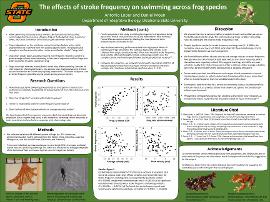| dc.contributor.author | Loper, Antonio | |
| dc.date.accessioned | 2021-04-20T13:37:12Z | |
| dc.date.available | 2021-04-20T13:37:12Z | |
| dc.date.issued | 2019-04-24 | |
| dc.identifier | oksd_loper_HT_2019 | |
| dc.identifier.uri | https://hdl.handle.net/11244/329362 | |
| dc.description.abstract | Many studies of comparative biomechanics look at few species, making it unclear how a diversity of body forms influences movement. Frogs demonstrate a unique chance to study such locomotive biomechanics, as they must be capable of multiple types of locomotion, depending on their ecological needs and environments as well as their morphological diversity. The purpose of this study is to combine data on swimming performance taken in the field and morphological measurements taken in the laboratory on an ecologically and morphologically diverse set of frog species in order to determine how various stroke frequencies relate to anuran swimming. In doing so, we hoped to determine how body form helps to dictate species’ mechanics and performance while swimming. After estimating each individual frog’s drag ratio (an approximation of drag divided by thrust) using morphological measurements, we compared each frog’s stroke frequency to their drag ratio, peak velocity, and average velocity. Our findings suggested that, because there were meaningful relationships between stroke frequency and both drag ratio and peak velocity but not with average velocity, frogs were able to modulate their stroke frequency in order to achieve more equitable average velocities regardless of body morphology. In this way, frogs acting under stronger drag and weaker thrust could still reach similar fitness levels (via similar average velocities used to escape predators) as other species acting under less drag and stronger thrust. | |
| dc.format | application/pdf | |
| dc.language | en_US | |
| dc.rights | Copyright is held by the author who has granted the Oklahoma State University Library the non-exclusive right to share this material in its institutional repository. Contact Digital Library Services at lib-dls@okstate.edu or 405-744-9161 for the permission policy on the use, reproduction or distribution of this material. | |
| dc.title | Effect of stroke frequency on swimming across frog species | |
| osu.filename | oksd_loper_HT_2019.pdf | |
| dc.type.genre | Honors Thesis | |
| dc.type.material | Text | |
| dc.contributor.director | Moen, Daniel | |
| dc.contributor.facultyreader | Santhanakrishnan, Arvind | |
| thesis.degree.discipline | Integrative Biology | |
| thesis.degree.grantor | Oklahoma State University | |
